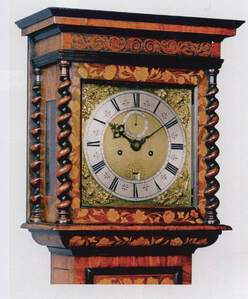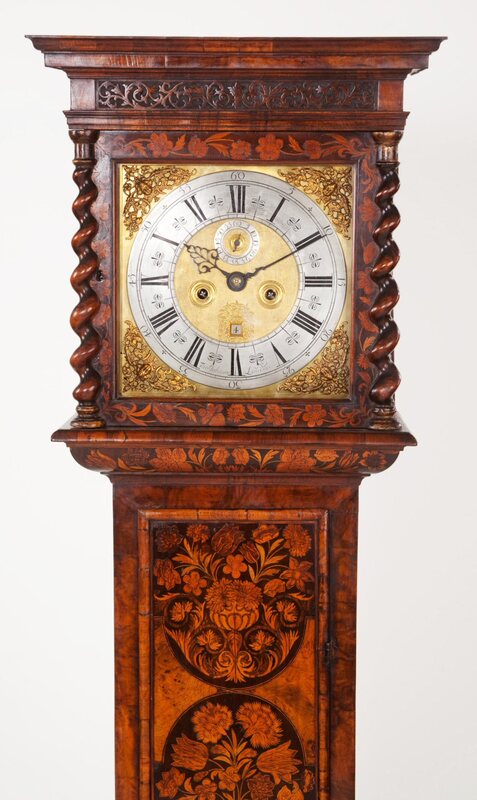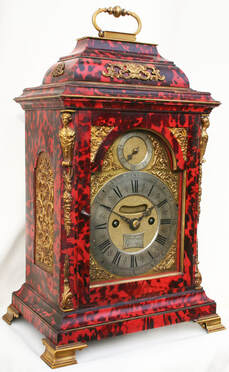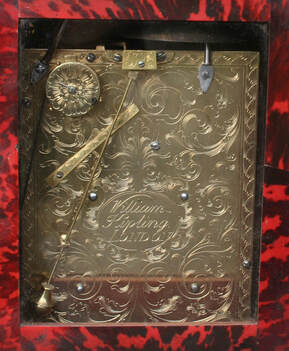|
One of the most important “great” clockmakers of the 17th century and probably the least well-known, was William Clement. He is the un-sung hero of horology. If it had not been for William Clement, clocks might still have been treated as objects of amusement and not useful timekeepers. William Clement invented the anchor escapement about 1665. He had been apprenticed to Thomas Chapman of the B.C. in 1657 and was freed by the B.C. in 1664. His elder brother Walter was an anchorsmith in Rotherhithe and lived in the family home. Their father, William, senior, had died in June 1646, almost 9 months before William’s baptism on 7th March 1647. So, we must assume that William was probably about 4 at that time. An earlier William who was baptised in 1638 must have died. William Clement, junior, must have assisted Walter from time to time, making his anchors which had prompted the idea of an anchor-shaped escapement. Most clocks prior to this were regulated with a verge escapement. A short bob pendulum was introduced to regulate the verge by Ahasaureus Fromanteel in the first longcase clocks made by him in 1658. The anchor escapement was regulated by the Royal Pendulum, 1 metre in length and beating once every second. Most of William Clement’s early clocks were turret clocks with anchor escapement and long pendulums, but one of his earliest longcase clocks was illustrated in “Horological Masterworks” published by the Antiquarian Horological Society in 2003, example number 19, has a very early movement. The Fromanteel type movement (with split front plate) had been altered during its construction. The plates had been marked out for a verge escapement, but the holes had not been drilled. The plates had been drilled for a cross-beat escapement, which presumably had been fitted, but then it had been fitted with an anchor escapement and a long 1 ¼ seconds pendulum. This early clock by William Clement could be the clock he experimented on when he was developing the anchor escapement. His turret clocks must have been more accurate than his competitors because in 1667 he received an order from the Society of Middle Temple (lawyers) for a clock to go over the entrance of their hall, which was to be better than the one on the hall of their fellow lawyers at Lincolns Inn. You can read more about his work and this clock here.
A very similar 8-day marquetry longcase clock made by Thomas Johnson, London c.1700 (fig.2) also has an 11inch square brass dial with cherub and scroll spandrels, but this has a deeper minute numbering band than the Clement clock, on the outside edge of the chapter ring. The matted dial centre has a seconds ring above, turning around the winding squares and engraving around a square date aperture. The hands on this clock are more ornately pierced and this dial is signed on the bottom of the chapter ring “Tho. Johnson London”. The movement has an anchor escapement, with seconds pendulum and inside count-wheel striking.
William Clement was held in high regard by his contemporaries who were always anxious to have his opinion on any horological matter. After he had introduced the anchor escapement c.1665 the Clockmakers’ Company (C.C) were determined to make him a member of their Company. William was a very modest man and for many years resisted their advances until eventually on 3 Dec. 1677 he gave in to their pressure and joined the Company as a free brother and “great” clockmaker. He still had to continue his commitment to the B.C. where he had sworn a lifetimes allegiance to that Company when he had been freed. He became an Assistant by 1680 and a reluctant Warden of the B.C. in 1697, while at the same time he was made an Assistant on 30 Sept.1678, a Warden on 15 Oct. 1690 and Master of the C.C. on 11 Oct 1694. Unfortunately, William Clement’s career ended in poverty as he was not able to work after c.1701 due to poor health and he died in 1709. His great achievement was recognised by his fellow craftsmen but has sadly been forgotten in later years until the present day when few people even in horological circles are aware of his achievements and that he was an exceptional clockmaker and worthy of our highest praise.
The chapter ring has a deep minute numbering band showing half quarters and half hour markers between the Roman hours. A name disc signed William Kipling London is situated below centre and blanked out false pendulum aperture above on the matted dial centre.
You can read more about William Clement here. And about other Great Clockmakers of the 17th Century here.
If you are interested in finding out more about all the Clock and Watchmakers in the Blacksmiths' Company from 16th -18th Century, then you might be interested in my latest book. Early Clock and watchmakers of the Blacksmiths' Company. If you would like to know more about Clockmakers from the North of England, then please consider buying a copy of Clockmakers of Northumberland and Durham. As usual, please leave your comments or questions regarding these or other clockmakers.
1 Comment
Graeme Power
4/4/2024 11:48:41 pm
Hi, I would like to buy this book if it mentions Lewis Levitt as a Blacksmith Company Clockmaker, I have been researching him and found he became a member of the WCC by redemption in 1832 without serving an apprenticeship so he must have been an accomplished Clockmaker well prior to this date, he also took his son as an apprentice Clockmaker on July 2 1832 which may have been why he wanted to join the WCC in the first place, it is all part of my research into a Longcase Clock in extremely poor condition I am restoring, could you pass this information to Mr Keith Bates as it may be of interest to him, I am happy to supply pictures with acknowledgement if requested to do so.
Reply
Leave a Reply. |
AuthorKeith Bates is an amateur horologist who has been researching clocks, watches and chronometers and their makers for over 30 years. Archives
August 2023
Categories
All
|





 RSS Feed
RSS Feed